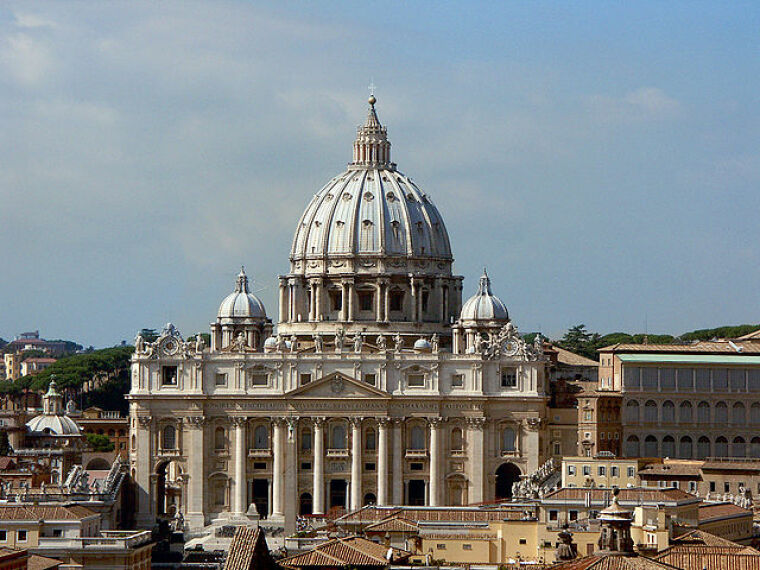Maintenance worker discovers bones attributed to St. Peter at 1,000-year-old Roman church

A maintenance worker has discovered bone fragments believed to belong to St. Peter during a routine restoration of a nearly 1,000-year-old church in Rome.
According to The Telegraph, the clay pots containing the bones were discovered when a worker lifted up a large marble slab near the medieval altar of the Church of Santa Maria in Cappella.
The church, located in the district of Trastevere, a medieval warren of cobbled lanes on the banks of the Tiber River, has been closed to the public for 35 years due to structural problems.
Apart from the bones of St. Peter, the inscription on the two Roman-era pots indicated that it also contained the bone fragments of three early popes — Cornelius, Callixtus and Felix — as well as four early Christian martyrs.
"There were two clay pots which were inscribed with the names of early popes – Peter, Felix, Callixtus and Cornelius," the worker told Italian television channel Rai Uno.
"I'm not an archaeologist but I understood immediately that they were very old. Looking at them, I felt very emotional," he added.
The worker immediately notified the deacon of the church, Massimiliano Floridi, who turned over the relics to the Vatican.
"We're waiting for a detailed study to be undertaken. A DNA comparison between these bones and those kept by the Vatican would shed light on the issue," said the deacon.
Angelus News noted that the existence of the bone fragments have been known for centuries, but the relics had never been found. A stone inscription inside the church indicated that the relics were kept alongside a piece of fabric taken from the dress of the Virgin Mary.
Santa Maria Church in Cappella is home to many other artifacts, including ceramics and murals dating back to the fourth century, as well as a fragment of the episcopal chair that was once a temporary seat of the Papal Consistory.
Some have theorized that the bones of St. Peter were brought to the church for protection under the rule of Pope Urban II, whose legitimacy was being challenged at the time by Clement III, an anti-pope backed by Emperor Henry IV.
According to tradition, St. Peter, who is considered by Roman Catholics to be the first pope, was crucified upside down in Rome in the first century A.D.
His remains were believed to have been interred in a tomb on a Vatican hill, where Emperor Constantine later built a church, which was replaced by St. Peter's Basilica in the 16th century.
During excavations under the basilica after World War II, archaeologists found a funerary monument with a casket built in honor of St. Peter and an engraving in Greek that read "Peter is here."
Experts who forensically examined the relics found in the casket in the 1960s concluded that the remains belonged to a man in his early sixties who lived in the first century A.D., prompting Pope Paul VI to declare them the bones of St. Peter in 1968.
 Christians don't have to affirm transgenderism, but they can’t express that view at work: tribunal
Christians don't have to affirm transgenderism, but they can’t express that view at work: tribunal Archaeology discovery: Medieval Christian prayer beads found on Holy Island
Archaeology discovery: Medieval Christian prayer beads found on Holy Island Presbyterian Church in America votes to leave National Association of Evangelicals
Presbyterian Church in America votes to leave National Association of Evangelicals Over 50 killed in 'vile and satanic' attack at Nigerian church on Pentecost Sunday
Over 50 killed in 'vile and satanic' attack at Nigerian church on Pentecost Sunday Ukrainian Orthodox Church severs ties with Moscow over Patriarch Kirill's support for Putin's war
Ukrainian Orthodox Church severs ties with Moscow over Patriarch Kirill's support for Putin's war Islamic State kills 20 Nigerian Christians as revenge for US airstrike
Islamic State kills 20 Nigerian Christians as revenge for US airstrike Man who served 33 years in prison for murder leads inmates to Christ
Man who served 33 years in prison for murder leads inmates to Christ


 Nigerian student beaten to death, body burned over ‘blasphemous’ WhatsApp message
Nigerian student beaten to death, body burned over ‘blasphemous’ WhatsApp message 'A new low': World reacts after Hong Kong arrests 90-year-old Cardinal Joseph Zen
'A new low': World reacts after Hong Kong arrests 90-year-old Cardinal Joseph Zen Iran sentences Christian man to 10 years in prison for hosting house church worship gathering
Iran sentences Christian man to 10 years in prison for hosting house church worship gathering French Guyana: Pastor shot dead, church set on fire after meeting delegation of Evangelicals
French Guyana: Pastor shot dead, church set on fire after meeting delegation of Evangelicals ‘Talking Jesus’ report finds only 6% of UK adults identify as practicing Christians
‘Talking Jesus’ report finds only 6% of UK adults identify as practicing Christians Mission Eurasia ministry center blown up in Ukraine, hundreds of Bibles destroyed: 'God will provide'
Mission Eurasia ministry center blown up in Ukraine, hundreds of Bibles destroyed: 'God will provide' Church holds service for first time after ISIS desecrated it 8 years ago
Church holds service for first time after ISIS desecrated it 8 years ago Burger King apologizes for 'offensive campaign' using Jesus' words at the Last Supper
Burger King apologizes for 'offensive campaign' using Jesus' words at the Last Supper Uganda: Muslims abduct teacher, burn him inside mosque for praying in Christ’s name
Uganda: Muslims abduct teacher, burn him inside mosque for praying in Christ’s name